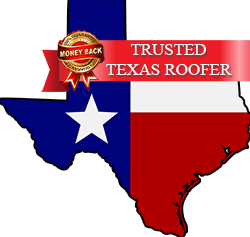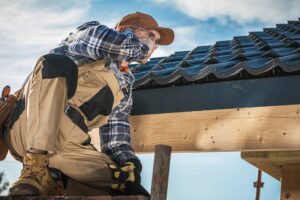Hailstorms are a common occurrence in Texas, particularly during the spring and summer months. While hail may seem like just a temporary inconvenience, the damage it can cause to your roof and home can be significant. Hailstones, ranging in size from small pellets to golf-ball-sized impacts, can weaken, crack, or even puncture roofing materials, leading to leaks, water damage, and costly repairs if not addressed promptly.
In this blog, we’ll walk you through what to do after a Texas hailstorm to assess and handle hail damage effectively, ensuring your roof stays protected and your home remains safe.
1. Assess the Situation Safely
Stay Safe and Wait for the All Clear
After a hailstorm, your first priority should be safety. Once the storm has passed, avoid going outside until the weather has fully cleared and it’s safe to do so. Keep in mind that hail may cause additional hazards, such as downed power lines, fallen tree branches, and flooded roads.
Look for Visible Signs of Damage
While you should avoid getting on the roof yourself, it is safe to inspect your property from the ground. Walk around your yard and look for:
- Dents or cracks in your shingles (particularly asphalt shingles, which can be vulnerable to hail damage).
- Damaged gutters or downspouts caused by the impact of the hailstones.
- Shingles that have been lifted or blown off.
- Granules from asphalt shingles scattered around the ground, which indicate shingle damage.
- Debris such as broken tree branches or other objects that may have impacted the roof.
Take pictures or videos of any visible damage for your insurance claim (more on this in a moment).
2. Call a Professional Roofing Contractor
Get a Roof Inspection ASAP
While you may be able to spot some surface-level damage, it’s essential to call a professional roofing contractor, such as Trophy Roofing and Construction, to perform a thorough roof inspection. Roof damage from hail can sometimes be hidden, with cracks or fractures that aren’t visible from the ground or even from the exterior of the house.
An experienced roofing contractor will look for:
- Dents or bruising in shingles, which could lead to cracks and leaks over time.
- Torn or missing shingles that may need replacing.
- Damage to the underlayment and roof deck, which may not be visible but can cause long-term issues.
- Damaged flashing around vents, chimneys, or skylights that could lead to water leaks.
A roofing expert can also check the attic for signs of water intrusion or structural damage that might not be immediately noticeable.
3. Document the Damage for Your Insurance Claim
File a Claim with Your Insurance Provider
Once you’ve had a professional roof inspection and identified the damage, the next step is to file a claim with your homeowners insurance. Insurance policies vary, but most homeowners insurance plans cover hail damage, particularly if you live in areas that are prone to storms.
Here are some tips for filing a successful hail damage insurance claim:
- Provide documentation: Share the photos and videos you took of the damage before any repairs are made. Include the professional inspection report provided by your roofing contractor.
- Review your policy: Ensure that hail damage is covered under your policy. Keep an eye out for deductibles or exclusions that may affect your claim.
- Get multiple estimates: Some insurance companies may require multiple repair estimates before processing your claim. Get quotes from reputable contractors and include these in your claim submission.
- Act quickly: Many insurance policies have time limits for filing claims. Make sure to file your claim as soon as possible after the storm.
4. Protect Your Home in the Interim
Temporary Repairs
If your roof has sustained damage, such as missing shingles or leaks, it’s important to take temporary action to protect your home from further damage until professional repairs can be made.
- Cover the affected areas with a tarp or plastic sheeting to prevent water from entering your home.
- Block leaks inside your home by using buckets or containers to catch drips and prevent water damage to walls and ceilings.
- Secure any loose debris around your yard, including broken tree branches, to prevent additional damage to your roof or property.
Many roofing contractors offer emergency tarp services after a storm, so don’t hesitate to reach out for immediate help.
5. Understand the Repair Process
Roof Repair vs. Roof Replacement
Depending on the extent of the hail damage, your roofing contractor will help you determine whether a repair is sufficient or if a full roof replacement is necessary.
- Minor damage: If the damage is limited to a few shingles or small sections of the roof, a repair may be all that’s needed. Shingles can be replaced, and any impacted areas can be patched up to restore the roof’s integrity.
- Severe damage: If the hailstorm caused widespread damage to the roof, including dents, cracks, or punctures to the shingles, underlayment, and deck, a full roof replacement may be required. While this can be a more significant investment, it ensures that your roof is entirely restored to a like-new condition, and your home remains protected.
Work with an Experienced Contractor
Ensure that your roofing contractor is experienced with hail damage repairs. At Trophy Roofing and Construction, we specialize in working with insurance claims and navigating the repair or replacement process with minimal hassle for homeowners.
6. Prevent Future Hail Damage
Consider Impact-Resistant Roofing Materials
If you live in an area prone to hailstorms, you may want to consider upgrading to more durable, impact-resistant roofing materials for future storms. Some options to consider include:
- Class 4 impact-resistant shingles: These shingles are specially designed to withstand hail and severe weather conditions.
- Metal roofing: Metal roofs are incredibly durable and less likely to suffer significant damage from hail, making them a great option in hail-prone areas.
While no roofing material is completely impervious to hail damage, impact-resistant options can significantly reduce the risk of costly repairs in the future.
How Trophy Roofing and Construction Can Help
At Trophy Roofing and Construction, we understand the impact that hailstorms can have on your roof and home. Our team is here to provide fast, professional inspections, assist with insurance claims, and ensure your roof is properly repaired or replaced after a storm.
We offer:
- Free roof inspections to assess hail damage and provide an accurate report for your insurance claim.
- Emergency tarp and temporary repairs to protect your home from further damage.
- Insurance claim assistance to help you navigate the process and ensure you get the coverage you deserve.
- Expert roof repairs and replacements to restore your home to its pre-storm condition.
Contact Us Today for Hail Damage Repair
If your roof has been damaged in a recent hailstorm, don’t wait to take action. Contact Trophy Roofing and Construction today for a professional inspection, detailed repair estimate, and assistance with your insurance claim. We’re here to help you protect your home and restore your roof after a storm.



